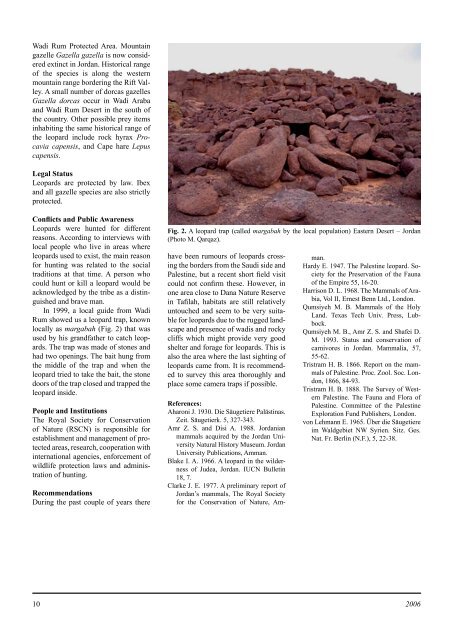Status and Conservation of the Leopard on the Arabian Peninsula ...
Status and Conservation of the Leopard on the Arabian Peninsula ...
Status and Conservation of the Leopard on the Arabian Peninsula ...
Create successful ePaper yourself
Turn your PDF publications into a flip-book with our unique Google optimized e-Paper software.
Wadi Rum Protected Area. Mountain<br />
gazelle Gazella gazella is now c<strong>on</strong>sidered<br />
extinct in Jordan. Historical range<br />
<str<strong>on</strong>g>of</str<strong>on</strong>g> <str<strong>on</strong>g>the</str<strong>on</strong>g> species is al<strong>on</strong>g <str<strong>on</strong>g>the</str<strong>on</strong>g> western<br />
mountain range bordering <str<strong>on</strong>g>the</str<strong>on</strong>g> Rift Valley.<br />
A small number <str<strong>on</strong>g>of</str<strong>on</strong>g> dorcas gazelles<br />
Gazella dorcas occur in Wadi Araba<br />
<str<strong>on</strong>g>and</str<strong>on</strong>g> Wadi Rum Desert in <str<strong>on</strong>g>the</str<strong>on</strong>g> south <str<strong>on</strong>g>of</str<strong>on</strong>g><br />
<str<strong>on</strong>g>the</str<strong>on</strong>g> country. O<str<strong>on</strong>g>the</str<strong>on</strong>g>r possible prey items<br />
inhabiting <str<strong>on</strong>g>the</str<strong>on</strong>g> same historical range <str<strong>on</strong>g>of</str<strong>on</strong>g><br />
<str<strong>on</strong>g>the</str<strong>on</strong>g> leopard include rock hyrax Procavia<br />
capensis, <str<strong>on</strong>g>and</str<strong>on</strong>g> Cape hare Lepus<br />
capensis.<br />
Legal <str<strong>on</strong>g>Status</str<strong>on</strong>g><br />
<str<strong>on</strong>g>Leopard</str<strong>on</strong>g>s are protected by law. Ibex<br />
<str<strong>on</strong>g>and</str<strong>on</strong>g> all gazelle species are also strictly<br />
protected.<br />
C<strong>on</strong>flicts <str<strong>on</strong>g>and</str<strong>on</strong>g> Public Awareness<br />
<str<strong>on</strong>g>Leopard</str<strong>on</strong>g>s were hunted for different<br />
reas<strong>on</strong>s. According to interviews with<br />
local people who live in areas where<br />
leopards used to exist, <str<strong>on</strong>g>the</str<strong>on</strong>g> main reas<strong>on</strong><br />
for hunting was related to <str<strong>on</strong>g>the</str<strong>on</strong>g> social<br />
traditi<strong>on</strong>s at that time. A pers<strong>on</strong> who<br />
could hunt or kill a leopard would be<br />
acknowledged by <str<strong>on</strong>g>the</str<strong>on</strong>g> tribe as a distinguished<br />
<str<strong>on</strong>g>and</str<strong>on</strong>g> brave man.<br />
In 1999, a local guide from Wadi<br />
Rum showed us a leopard trap, known<br />
locally as margabah (Fig. 2) that was<br />
used by his gr<str<strong>on</strong>g>and</str<strong>on</strong>g>fa<str<strong>on</strong>g>the</str<strong>on</strong>g>r to catch leopards.<br />
The trap was made <str<strong>on</strong>g>of</str<strong>on</strong>g> st<strong>on</strong>es <str<strong>on</strong>g>and</str<strong>on</strong>g><br />
had two openings. The bait hung from<br />
<str<strong>on</strong>g>the</str<strong>on</strong>g> middle <str<strong>on</strong>g>of</str<strong>on</strong>g> <str<strong>on</strong>g>the</str<strong>on</strong>g> trap <str<strong>on</strong>g>and</str<strong>on</strong>g> when <str<strong>on</strong>g>the</str<strong>on</strong>g><br />
leopard tried to take <str<strong>on</strong>g>the</str<strong>on</strong>g> bait, <str<strong>on</strong>g>the</str<strong>on</strong>g> st<strong>on</strong>e<br />
doors <str<strong>on</strong>g>of</str<strong>on</strong>g> <str<strong>on</strong>g>the</str<strong>on</strong>g> trap closed <str<strong>on</strong>g>and</str<strong>on</strong>g> trapped <str<strong>on</strong>g>the</str<strong>on</strong>g><br />
leopard inside.<br />
People <str<strong>on</strong>g>and</str<strong>on</strong>g> Instituti<strong>on</strong>s<br />
The Royal Society for <str<strong>on</strong>g>C<strong>on</strong>servati<strong>on</strong></str<strong>on</strong>g><br />
<str<strong>on</strong>g>of</str<strong>on</strong>g> Nature (RSCN) is resp<strong>on</strong>sible for<br />
establishment <str<strong>on</strong>g>and</str<strong>on</strong>g> management <str<strong>on</strong>g>of</str<strong>on</strong>g> protected<br />
areas, research, cooperati<strong>on</strong> with<br />
internati<strong>on</strong>al agencies, enforcement <str<strong>on</strong>g>of</str<strong>on</strong>g><br />
wildlife protecti<strong>on</strong> laws <str<strong>on</strong>g>and</str<strong>on</strong>g> administrati<strong>on</strong><br />
<str<strong>on</strong>g>of</str<strong>on</strong>g> hunting.<br />
Recommendati<strong>on</strong>s<br />
During <str<strong>on</strong>g>the</str<strong>on</strong>g> past couple <str<strong>on</strong>g>of</str<strong>on</strong>g> years <str<strong>on</strong>g>the</str<strong>on</strong>g>re<br />
Fig. 2. A leopard trap (called margabah by <str<strong>on</strong>g>the</str<strong>on</strong>g> local populati<strong>on</strong>) Eastern Desert – Jordan<br />
(Photo M. Qarqaz).<br />
have been rumours <str<strong>on</strong>g>of</str<strong>on</strong>g> leopards crossing<br />
<str<strong>on</strong>g>the</str<strong>on</strong>g> borders from <str<strong>on</strong>g>the</str<strong>on</strong>g> Saudi side <str<strong>on</strong>g>and</str<strong>on</strong>g><br />
Palestine, but a recent short field visit<br />
could not c<strong>on</strong>firm <str<strong>on</strong>g>the</str<strong>on</strong>g>se. However, in<br />
<strong>on</strong>e area close to Dana Nature Reserve<br />
in Tafilah, habitats are still relatively<br />
untouched <str<strong>on</strong>g>and</str<strong>on</strong>g> seem to be very suitable<br />
for leopards due to <str<strong>on</strong>g>the</str<strong>on</strong>g> rugged l<str<strong>on</strong>g>and</str<strong>on</strong>g>scape<br />
<str<strong>on</strong>g>and</str<strong>on</strong>g> presence <str<strong>on</strong>g>of</str<strong>on</strong>g> wadis <str<strong>on</strong>g>and</str<strong>on</strong>g> rocky<br />
cliffs which might provide very good<br />
shelter <str<strong>on</strong>g>and</str<strong>on</strong>g> forage for leopards. This is<br />
also <str<strong>on</strong>g>the</str<strong>on</strong>g> area where <str<strong>on</strong>g>the</str<strong>on</strong>g> last sighting <str<strong>on</strong>g>of</str<strong>on</strong>g><br />
leopards came from. It is recommended<br />
to survey this area thoroughly <str<strong>on</strong>g>and</str<strong>on</strong>g><br />
place some camera traps if possible.<br />
References:<br />
Ahar<strong>on</strong>i J. 1930. Die Säugetiere Palästinas.<br />
Zeit. Säugetierk. 5, 327-343.<br />
Amr Z. S. <str<strong>on</strong>g>and</str<strong>on</strong>g> Disi A. 1988. Jordanian<br />
mammals acquired by <str<strong>on</strong>g>the</str<strong>on</strong>g> Jordan University<br />
Natural History Museum. Jordan<br />
University Publicati<strong>on</strong>s, Amman.<br />
Blake I. A. 1966. A leopard in <str<strong>on</strong>g>the</str<strong>on</strong>g> wilderness<br />
<str<strong>on</strong>g>of</str<strong>on</strong>g> Judea, Jordan. IUCN Bulletin<br />
18, 7.<br />
Clarke J. E. 1977. A preliminary report <str<strong>on</strong>g>of</str<strong>on</strong>g><br />
Jordan’s mammals, The Royal Society<br />
for <str<strong>on</strong>g>the</str<strong>on</strong>g> <str<strong>on</strong>g>C<strong>on</strong>servati<strong>on</strong></str<strong>on</strong>g> <str<strong>on</strong>g>of</str<strong>on</strong>g> Nature, Am-<br />
man.<br />
Hardy E. 1947. The Palestine leopard. Society<br />
for <str<strong>on</strong>g>the</str<strong>on</strong>g> Preservati<strong>on</strong> <str<strong>on</strong>g>of</str<strong>on</strong>g> <str<strong>on</strong>g>the</str<strong>on</strong>g> Fauna<br />
<str<strong>on</strong>g>of</str<strong>on</strong>g> <str<strong>on</strong>g>the</str<strong>on</strong>g> Empire 55, 16-20.<br />
Harris<strong>on</strong> D. L. 1968. The Mammals <str<strong>on</strong>g>of</str<strong>on</strong>g> Arabia,<br />
Vol II, Ernest Benn Ltd., L<strong>on</strong>d<strong>on</strong>.<br />
Qumsiyeh M. B. Mammals <str<strong>on</strong>g>of</str<strong>on</strong>g> <str<strong>on</strong>g>the</str<strong>on</strong>g> Holy<br />
L<str<strong>on</strong>g>and</str<strong>on</strong>g>. Texas Tech Univ. Press, Lubbock.<br />
Qumsiyeh M. B., Amr Z. S. <str<strong>on</strong>g>and</str<strong>on</strong>g> Shafei D.<br />
M. 1993. <str<strong>on</strong>g>Status</str<strong>on</strong>g> <str<strong>on</strong>g>and</str<strong>on</strong>g> c<strong>on</strong>servati<strong>on</strong> <str<strong>on</strong>g>of</str<strong>on</strong>g><br />
carnivores in Jordan. Mammalia, 57,<br />
55-62.<br />
Tristram H. B. 1866. Report <strong>on</strong> <str<strong>on</strong>g>the</str<strong>on</strong>g> mammals<br />
<str<strong>on</strong>g>of</str<strong>on</strong>g> Palestine. Proc. Zool. Soc. L<strong>on</strong>d<strong>on</strong>,<br />
1866, 84-93.<br />
Tristram H. B. 1888. The Survey <str<strong>on</strong>g>of</str<strong>on</strong>g> Western<br />
Palestine. The Fauna <str<strong>on</strong>g>and</str<strong>on</strong>g> Flora <str<strong>on</strong>g>of</str<strong>on</strong>g><br />
Palestine. Committee <str<strong>on</strong>g>of</str<strong>on</strong>g> <str<strong>on</strong>g>the</str<strong>on</strong>g> Palestine<br />
Explorati<strong>on</strong> Fund Publishers, L<strong>on</strong>d<strong>on</strong>.<br />
v<strong>on</strong> Lehmann E. 1965. Über die Säugetiere<br />
im Waldgebiet NW Syrien. Sitz. Ges.<br />
Nat. Fr. Berlin (N.F.), 5, 22-38.<br />
10 2006


